
想了解更多关于开源的移植内容,请访问:

51CTO 开源基础软件社区

https://ost.51cto.com

OpenHarmony系统移植最核心的内核步骤是内核的移植,内核的移植稳定是一切子系统稳定的基础,上一篇我们讲述了内核启动原理,瘦设备实战以及vendor、内核board的移植开发配置,本文将介绍SoC层级的瘦设备实战移植适配流程。
SoC配置芯片层级编译依赖库,移植包括CMSIS、HAL(硬件抽象层)等,这里包含操作总线、串口、时钟、寄存等库函数。
目录名称按照芯片厂家、芯片型号来创建,比如st公司下的stm32f4xx系列芯片。
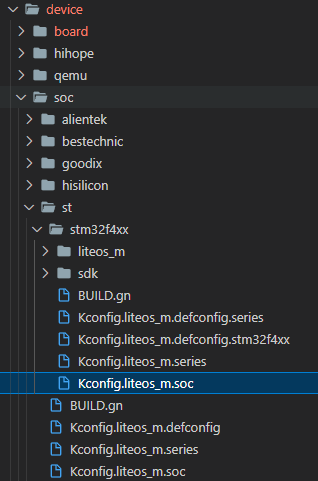
配置文件内容如下:
device/soc/st/stm32f4xx/Kconfig.liteos_m.defconfig.seriesif SOC_SERIES_STM32F4xxrsource "Kconfig.liteos_m.defconfig.stm32f4xx"config SOC_SERIESstringdefault "stm32f4xx"endifdevice/soc/st/stm32f4xx/Kconfig.liteos_m.defconfig.stm32f4xxconfig SOCstringdefault "stm32f4xx"depends on SOC_STM32F4xxdevice/soc/st/stm32f4xx/Kconfig.liteos_m.seriesconfig SOC_SERIES_STM32F4xxbool "STMicroelectronics STM32F4xx series"select ARCH_ARMselect SOC_COMPANY_STMICROELECTRONICSselect CPU_CORTEX_M4helpEnable support for STMicroelectronics STM32F4xx seriesdevice/soc/st/stm32f4xx/Kconfig.liteos_m.socchoiceprompt "STMicroelectronics STM32F4xx series SoC"depends on SOC_SERIES_STM32F4xxconfig SOC_STM32F407bool "SoC STM32F407"Endchoicedevice/soc/st/Kconfig.liteos_m.defconfigrsource "*/Kconfig.liteos_m.defconfig.series"device/soc/st/Kconfig.liteos_m.defconfigrsource "*/Kconfig.liteos_m.series"device/soc/st/Kconfig.liteos_m.socconfig SOC_COMPANY_STMICROELECTRONICSboolif SOC_COMPANY_STMICROELECTRONICSconfig SOC_COMPANYdefault "st"rsource "*/Kconfig.liteos_m.soc"endif # SOC_COMPANY_STMICROELECTRONICSdevice/soc/st/BUILD.gnif (ohos_kernel_type == "liteos_m") { import("//kernel/liteos_m/liteos.gni")module_name = get_path_info(rebase_path("."), "name")module_group(module_name) { modules = [ "stm32f4xx" ]}}device/soc/st/stm32f4xx/BUILD.gnif (ohos_kernel_type == "liteos_m") { import("//kernel/liteos_m/liteos.gni")module_name = get_path_info(rebase_path("."), "name")module_group(module_name) { modules = [ "liteos_m", "sdk" ]}}对于STM32F407我们可以使用官方的STM32CubeMX生成对应的标准的hal库函数文件。
(1)选择ACCESS TO MCU SELECTOR。
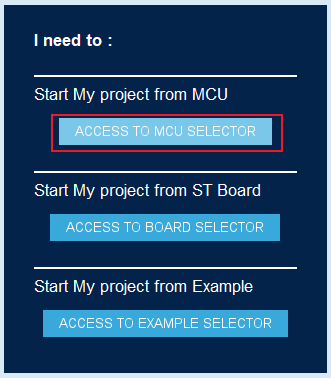
(2)勾选Arm Cortex-M4 --> STM32F4 --> STM32F407ZGTx。

(3)填写工程名称,选择工程保存路径,选择Makefile作为编译工具,点击GENERATE CODE生成工程代码。

(4)使用vscode打开目录,我们得到如下工程。

回顾一下之前讲过的系统启动的流程:
接下来我们将HAL库函数文件及芯片头文件迁移到OH代码中,文件路径如下:
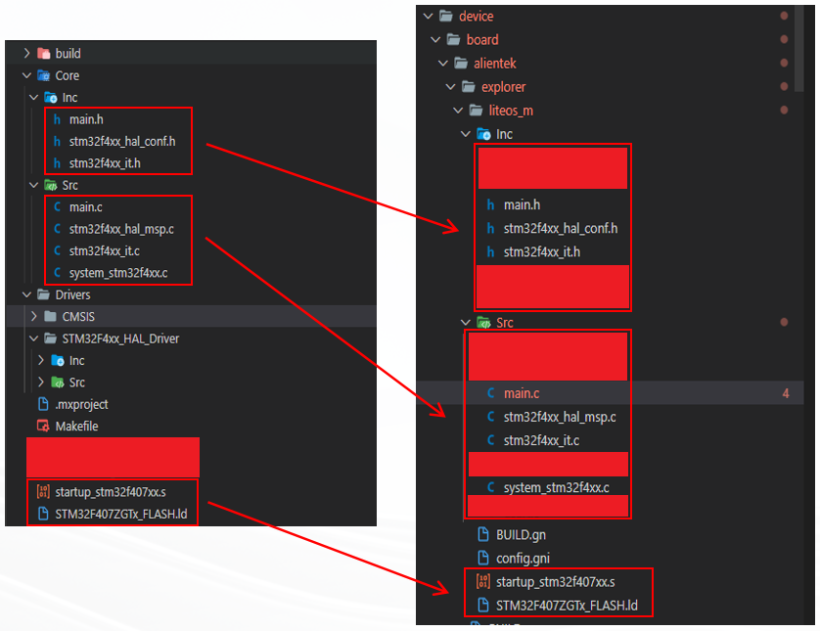
将Drivers中的CMSIS、STM32F4xx_HAL_Driver复制到/device/soc/st/stm32f4xx/sdk/Drivers中。
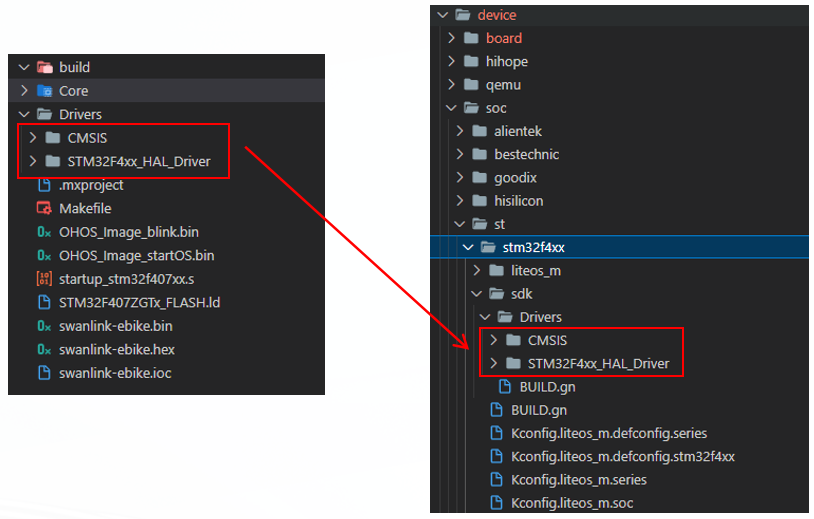
使用OH的gn以及config文件配置系统编译流程以及包依赖关系,涉及到的配置文件如下:
device/board/alientek/explorer/liteos_m/config.gni# Kernel type, e.g. "linux", "liteos_a", "liteos_m".kernel_type = "liteos_m"# Kernel version.kernel_version = "3.0.0"# Board CPU type, e.g. "cortex-a7", "riscv32".board_cpu = "cortex-m4"# Board arch, e.g. "armv7-a", "rv32imac".board_arch = ""# Toolchain name used for system compiling.# E.g. gcc-arm-none-eabi, arm-linux-harmonyeabi-gcc, ohos-clang, riscv32-unknown-elf.# Note: The default toolchain is "ohos-clang". It's not mandatory if you use the default toolchain.board_toolchain = "arm-none-eabi-gcc"use_board_toolchain = true# The toolchain path installed, it's not mandatory if you have added toolchain path to your ~/.bashrc.board_toolchain_path = ""# Compiler prefix.board_toolchain_prefix = "arm-none-eabi-"# Compiler type, "gcc" or "clang".board_toolchain_type = "gcc"#Debug compiler optimization level optionsboard_opt_flags = ["-mcpu=cortex-m4","-mthumb","-mfpu=fpv4-sp-d16","-mfloat-abi=hard",]# Board related common compile flags.board_cflags = ["-Og","-Wall","-fdata-sections","-ffunction-sections","-DSTM32F407xx","-DHAL_UART_MODULE_ENABLED"]board_cflags += board_opt_flagsboard_asmflags = ["-Og","-Wall","-fdata-sections","-ffunction-sections",]board_asmflags += board_opt_flagsboard_cxx_flags = board_cflagsboard_ld_flags = ["-T${ ohos_root_path}device/board/alientek/explorer/liteos_m/STM32F407ZGTx_FLASH.ld"]board_ld_flags += board_opt_flags# Board related headfiles search path.board_include_dirs = [ "//utils/native/lite/include" ]# Board adapter dir for OHOS components.board_adapter_dir = ""这里的核心工作就是将原有的Makefile编译文件翻译成OH的config.gni,可以看到有很多的编译参数以及宏变量定义。修改编译依赖文件BUILD.gndevice/board/alientek/explorer/liteos_m/BUILD.gnimport("//kernel/liteos_m/liteos.gni")module_name = get_path_info(rebase_path("."), "name")kernel_module(module_name) { sources = ["startup_stm32f407xx.s","Src/main.c","Src/delay.c","Src/led.c","Src/sys.c","Src/usart.c","Src/stm32f4xx_hal_msp.c","Src/stm32f4xx_it.c","Src/system_stm32f4xx.c",]include_dirs = [ "Inc",]}# "-Wl,-T" + rebase_path("STM32F407ZGTx_FLASH.ld"),config("public") { ldflags = ["-Wl,-u_printf_float"]libs = ["c","m","nosys",]}device/soc/st/stm32f4xx/sdk/BUILD.gnimport("//kernel/liteos_m/liteos.gni")module_name = "stm32f4xx_sdk"kernel_module(module_name) { asmflags = board_asmflagssources = ["Drivers/STM32F4xx_HAL_Driver/Src/stm32f4xx_hal_rcc.c","Drivers/STM32F4xx_HAL_Driver/Src/stm32f4xx_hal_rcc_ex.c","Drivers/STM32F4xx_HAL_Driver/Src/stm32f4xx_hal_gpio.c","Drivers/STM32F4xx_HAL_Driver/Src/stm32f4xx_hal_dma_ex.c","Drivers/STM32F4xx_HAL_Driver/Src/stm32f4xx_hal_dma.c","Drivers/STM32F4xx_HAL_Driver/Src/stm32f4xx_hal_cortex.c","Drivers/STM32F4xx_HAL_Driver/Src/stm32f4xx_hal.c","Drivers/STM32F4xx_HAL_Driver/Src/stm32f4xx_hal_exti.c","Drivers/STM32F4xx_HAL_Driver/Src/stm32f4xx_hal_uart.c",]include_dirs = ["//device/board/alientek/explorer/liteos_m/Inc"]}#指定全局头文件搜索路径config("public") { include_dirs = ["Drivers/STM32F4xx_HAL_Driver/Inc","Drivers/CMSIS/Device/ST/STM32F4xx/Include",]}我们对device/board/alientek/explorer/liteos_m/Src/main.c文件进行如下编辑。
int main(void){ HAL_Init(); /* 初始化HAL库 */sys_stm32_clock_init(336, 8, 2, 7); /* 初始化时钟频率168Mhz */delay_init(168); /* 延时初始化 */printf("hal、系统始终初始化完毕,开始启动系统...\n");RunTask();}void RunTask(){ unsigned int ret;ret = LOS_KernelInit(); // 初始化LiteOS系统if (ret != LOS_OK){ printf("Liteos kernel init failed! ERROR: 0x%x\n", ret);}else{ LOS_Start(); // 启动系统}...}使用hb工具进行编译,hb set选择编译目标,hb build -f执行编译。
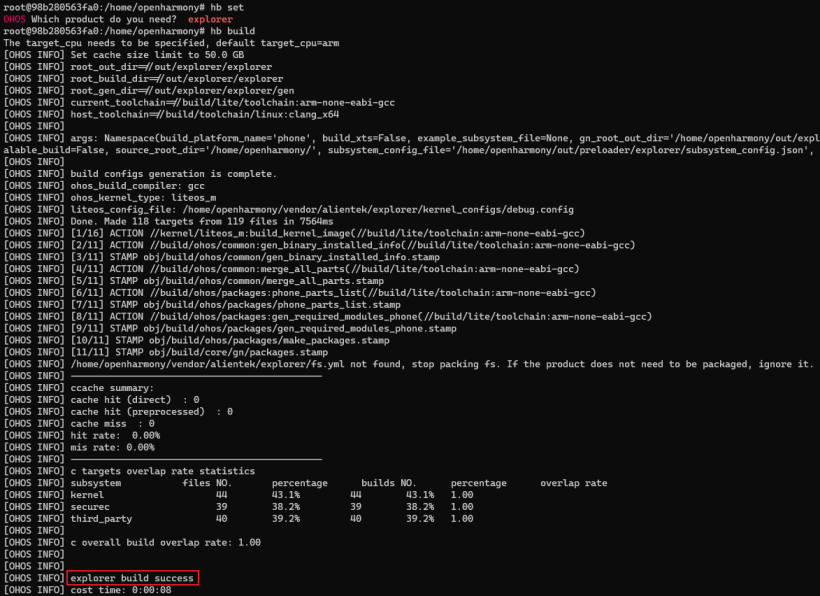
日志输出explorer build success表示编译成功。
编译过程中可能会遇到缺少某些结构体或者函数的定义,需要细心排查,注意宏定义是否打开。
STM32F407开发板支持串口和ST-LINK烧录方式,但OH编译出来的是bin文件,bin无法直接通过串口烧录。需要用到ST-LINK工具进行烧录,烧录时需要指定flash,开始地址:0x08000000,大小:0x100000。

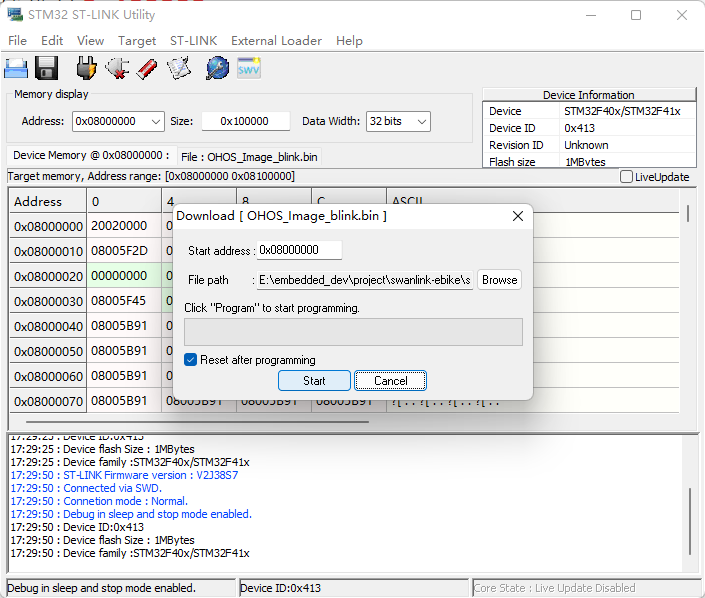
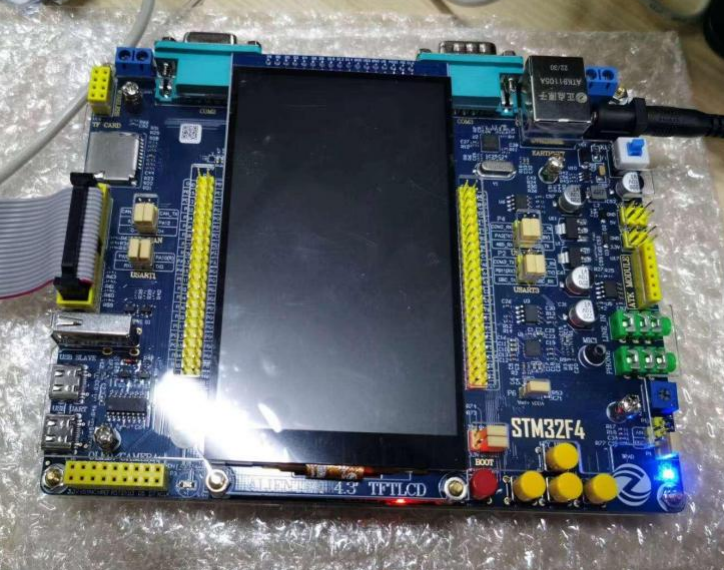
本文主要讲述了OpenHarmony内核的SoC代码移植。因为STM32F407的架构和基础SDK都是官方开源的,所以移植工作也较为容易,但在实际工作中如果遇到未开源的芯片,那么需要模组或芯片厂商提供技术支持才可完成移植工作。到这里瘦设备OH适配的最核心工作已完成,希望能对热爱OpenHarmony的小伙伴有所帮助。
想了解更多关于开源的内容,请访问:
51CTO 开源基础软件社区
https://ost.51cto.com
责任编辑:jianghua 来源: 51CTO 开源基础软件社区 鸿蒙内核移植(责任编辑:休闲)
 美联储加息什么意思?美联储加息是指联邦储备系统管理委员会在华盛顿召开议息会议后,决定货币政策的调整,是否上调利率。简单的说,加息是一种紧缩型货币政策,美联储通过加息来应对当前的经济。一般加息可以提高银
...[详细]
美联储加息什么意思?美联储加息是指联邦储备系统管理委员会在华盛顿召开议息会议后,决定货币政策的调整,是否上调利率。简单的说,加息是一种紧缩型货币政策,美联储通过加息来应对当前的经济。一般加息可以提高银
...[详细]传声营销成立视觉营销事业部 服务B2B企业不断上升的视频营销需求
 (2021年4月8日,上海)中国B2B营销服务的领跑者传声营销宣布成立新的视觉营销事业部,全力满足B2B企业不断上升的短视频营销需求。新的事业部主营短视频营销的规划、制作和运营。针对去年11月正式推出
...[详细]
(2021年4月8日,上海)中国B2B营销服务的领跑者传声营销宣布成立新的视觉营销事业部,全力满足B2B企业不断上升的短视频营销需求。新的事业部主营短视频营销的规划、制作和运营。针对去年11月正式推出
...[详细] 本田即将上任的首席执行官三部敏宏表示,计划利用新的电池技术来降低成本,开发更经济的小型电动汽车。在此之前,本田将继续销售价格更高、体积更大的电动汽车。但三部敏宏承认,由于电动汽车市场不稳定,很难制定计
...[详细]
本田即将上任的首席执行官三部敏宏表示,计划利用新的电池技术来降低成本,开发更经济的小型电动汽车。在此之前,本田将继续销售价格更高、体积更大的电动汽车。但三部敏宏承认,由于电动汽车市场不稳定,很难制定计
...[详细]鲸准极速融资举行「融资问诊」企业服务专场 助力创业者加速融资
 3月22日,鲸准&Capital Coffee发起创投老中医「融资问诊」线上沙龙活动第03期“企业服务”专场,邀请行业资深创投嘉宾,为广大 to B方向创业者分享2021年企业服务赛道大趋势,
...[详细]
3月22日,鲸准&Capital Coffee发起创投老中医「融资问诊」线上沙龙活动第03期“企业服务”专场,邀请行业资深创投嘉宾,为广大 to B方向创业者分享2021年企业服务赛道大趋势,
...[详细] 股指期货是什么意思?股票指数期货是指以股票价格指数作为标的物的金融期货合约,在具体交易时,股票指数期货合约的价值是用指数的点数乘以事先规定的单位金额来加以计算的。股指期货可以进行双向操作,存在保证金制
...[详细]
股指期货是什么意思?股票指数期货是指以股票价格指数作为标的物的金融期货合约,在具体交易时,股票指数期货合约的价值是用指数的点数乘以事先规定的单位金额来加以计算的。股指期货可以进行双向操作,存在保证金制
...[详细]原创TV动画《THE MARGINAL SERVICE》4月11日首播
 Cygames 的原创 TV 动画《THE MARGINALSERVICE境界服务)》官方网站今天3月 3 日)公布了动画的正式 PV 和新主视觉图。新预告揭晓了动画的跟多制作人员,以及宣布了将于 4
...[详细]
Cygames 的原创 TV 动画《THE MARGINALSERVICE境界服务)》官方网站今天3月 3 日)公布了动画的正式 PV 和新主视觉图。新预告揭晓了动画的跟多制作人员,以及宣布了将于 4
...[详细] 今日3月2日),世嘉公布了全新青春RPG游戏《LOOP8 降神》的中文开场影片,其中,登场角色生动的表情和片头主题曲是其中的精彩亮点!一起来看看吧。《LOOP8降神》中文版将于6月1日登陆Switch
...[详细]
今日3月2日),世嘉公布了全新青春RPG游戏《LOOP8 降神》的中文开场影片,其中,登场角色生动的表情和片头主题曲是其中的精彩亮点!一起来看看吧。《LOOP8降神》中文版将于6月1日登陆Switch
...[详细]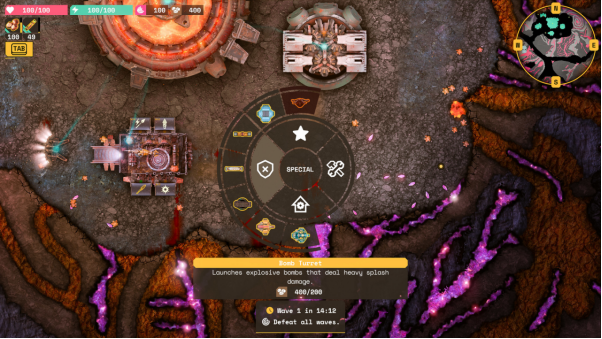 在Steam上获得“特别好评”的挖矿塔防生存建设游戏《深岩破裂者(Lumencraft)》宣布于3月1日脱离EA抢先体验阶段,推出1.0正式版,游戏正式版国区Steams首周可享受30%折扣,仅需41
...[详细]
在Steam上获得“特别好评”的挖矿塔防生存建设游戏《深岩破裂者(Lumencraft)》宣布于3月1日脱离EA抢先体验阶段,推出1.0正式版,游戏正式版国区Steams首周可享受30%折扣,仅需41
...[详细] 近日,中国中铁旗下中铁工业研制的世界首台桩梁一体智能造桥机“共工号”投入使用,在深(圳)汕(尾)高速公路西段改扩建工程梅陇特大桥顺利完成10跨作业,实现了工厂化预制、精益化管理
...[详细]
近日,中国中铁旗下中铁工业研制的世界首台桩梁一体智能造桥机“共工号”投入使用,在深(圳)汕(尾)高速公路西段改扩建工程梅陇特大桥顺利完成10跨作业,实现了工厂化预制、精益化管理
...[详细] 据日前消息,《暗黑破坏神》的联合创始人之一Erich Schaefer加入了由前《暗黑破坏神2》开发者成立的新工作室 Moon Beast Productions,以开发新的动作角色扮演游戏。此前新闻
...[详细]
据日前消息,《暗黑破坏神》的联合创始人之一Erich Schaefer加入了由前《暗黑破坏神2》开发者成立的新工作室 Moon Beast Productions,以开发新的动作角色扮演游戏。此前新闻
...[详细]